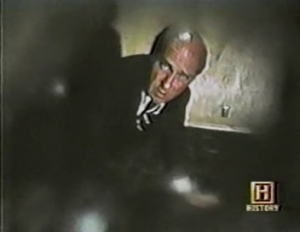In Search Of S03E14 Dreams and Nightmares
Dreams and Nightmares has one of the most atmospheric openings so far. Unsettling music plays over creepy imagery, which resolves into a man having a nightmare. Nimoy begins talking about dreams over the silhouette of a man in lotus position, with his body swirls and changes colour.
 It’s pretty trippy, is what I’m saying.
It’s pretty trippy, is what I’m saying.
Anyway, Nimoy’s big argument is that soon we’ll be able to control our dreams. Fascinating — if true.
More atmosphere building is next. Nimoy gives a poetic description of dreaming over footage of a woman going to bed, then having a nightmare about an intruder. This is followed by some beautifully unsettling nightmare imagery directed straight at camera. Tell you what, I’m impressed so far.
Nimoy, sitting on a bed, talks about the supposed significance of dreams over a series of artistic depiction of dreams from different cultures. Then, in one of those lovely In Search Of… sudden changes of gear, we’re in a lab where sleep is being studied. White coated men and women put electrodes on the head of a woman who goes to sleep. Nimoy explains the concept of the stages of sleep, including REM. There’s a very endearing time lapse of a young couple shifting around in their sleep, as Nimoy explains more about sleep processes. It sounds pretty correct but a) I’m no expert and b) what I know may well be out of date.
Moving onto a scientist using a massive 1970s computer. It is Dr Alan Hobson an expert in sleep in humans and cats. Why cats? No idea. Cool, but. Dr Hobson talks about how the dreaming sleep state is generated by nerves in the brain.
More nightmare imagery, interspersed with creepy electronic graph lines. Honestly starting to think that the rest of the episode is just an excuse to keep doing these nightmares. Not complaining if it is. They’re pretty awesome.
Dr Rosalyn Cartwright is trying to figure out why people dream by attaching electrodes to women with depression. She says she’s interested in the effect of stress on the dream state. Nimoy says she’s interested in the ‘healing purpose’ of dreams. Dr Cartwright says she believes that dreaming is about recentering your sense of self, which is a theory I hadn’t heard before. Dr Cartwright and her assistant wear white coats as they watch enormous computer monitors. Then their test subject wakes up and explains her dream, which is about as much fun as people explaining their dreams usually is. Next day, Cartwright and her subject have a little chat about her dream, in which she sees her ex-husband as a beer drinking polecat. I have to admit, the symbolism is a little obscure here.
Now we’re looking at a recreation of a dream by a balding guy who’s having stress dreams after losing his job. My keen knowledge of the 1970s tell me that he should blame his job loss on stagflation, or possibly KISS. After reading for a while to mournful electronic music, he drifts off.
The music gets creepier and we see the dream sequence in greater detail. It’s… so cool. I can’t do it justice. The mix of genuinely unsettling images with random electronic lights, like from an early music video… It’s something to behold. The imagery continues as Nimoy talks about sleep paralysis and then… now we’re back in the lab. Boring… No, wait, we’re looking at footage of people suffering from night terrors, which is pretty sweet. We talk next to Dr Anthony Hale, who looks like he’s going to a casting call for ‘late 70s accountant #1’. He talks about how people with night terrors can’t recall their dreams. And back to the people waking up from night terrors, which is more fun.
Looking now at a series of nightmarish artistic images while Nimoy talks about the difference in how dreams were interpreted before and after Freud. Now we’re looking at pictures that children drew of their nightmares, which is cool. Lots of Kaiju. And… aw! Now they’ve made some adorable children nightmare sequences. A kid on a tricycle is attacked by a gorilla. Well, not really, the tricycle footage is intercut with the gorilla footage. Dr Hale talks about children’s nightmares like he was explaining the California tax code.
More nightmare images, more psychobabble. Therapist Christine San Filipo is shown waking from a nightmare and recording it in her dream diary. Her nightmare is being chased by the ocean, which sounds like bad television, but judicious editing and sound effects really make the waves seem creepy. We move on to Christine’s dream circle therapy group, which is totally a thing. Oh… so seventies. So much silver eyeshadow. So many giant ear rings.
Nimoy claims that by understanding her dreams, she’s come to have better dreams. Christine says that she’s become a more sociable person, and her dream seems to have moved on from ‘drowning in the ocean’ to ‘getting a backrub by two people who look like they’re in a cult.’
Back to the silhouette yoga guy. Nimoy talks about Jung, because why not? He says that writing down your dreams in the morning can help you control your dreams, which is basically the only time that the premise of the episode is brought up.
Not a bad episode, all in all. The stuff on dream states is pretty old hat now, but it was probably close to cutting edge in the late 1970s. And those nightmare sequences were really cool. I can’t come close to doing them justice – they’re very short and creepy, but if I write them up in too much detail they seem silly. Like a lot of nightmares, I guess.
Quotes
“On the viewscreens of our minds, feelings are magically transformed into pictures.” — Nimoy
Summing Up
Dream imagery: 8/10, Actual science: 7/10 I guess?, Music 9/10, Nimoyness: 8/10, Generally okay episodeness: 8/10. Overall: 40/50. Distinction.



